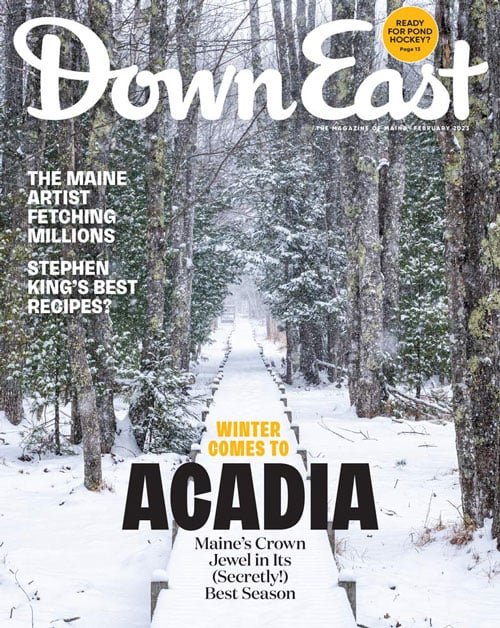By Jesse Ellison
From our February 2023 issue
Jaime DeSimone has been visiting Rockland’s Farnsworth Art Museum for so long, she can’t remember her first trip. Childhood vacations involved museum-hopping Route 1 road trips between her family’s Massachusetts home and Mount Desert Island. When she studied art history at Bates College, around the turn of the aughts, Maine museums like the Farnsworth were “her textbooks.” She’s since done curatorial work at museums across the country, specializing in contemporary art, most recently at the Portland Museum of Art. Last summer, she became the Farnsworth’s chief curator, arriving just in time to help shepherd the museum’s 75th-anniversary reinstallation.
The museum reopens in February after a five-week closure and massive overhaul of the permanent-collection exhibition galleries. The new approach shows off new acquisitions and groups artwork thematically: One room focuses on Maine industry, with pieces related to fishing, say, or Rockland’s historic granite quarries. Another is devoted to landscapes, with work exploring places real and imagined. Another is full of art concerned with the sea. Placards offer not only descriptions and background but also questions and prompts, which DeSimone hopes will help prompt moments of “personal discovery, rather than just a static experience.” We spoke to DeSimone about the anniversary revamp and more.
What attracted you to the position at the Farnsworth?
I love Maine, and I believe there’s something special happening here that has informed and directed American art in a way that not many places have. The Farnsworth is the only museum with this mission to celebrate Maine and American art — others carry and share that responsibility, but it really is the Farnsworth where all of our collections strategy goes back to that mission, all of our exhibition program goes back to that mission. And there is a lot to celebrate here.
What makes Maine so exceptional in its relationship to American art?
The artistic community here is endless, which gives us a lot of opportunities and moments of discovery that I don’t think people expect. Every little peninsula, every community, I know there’s some artists there doing something. And I hope they’re really proud of it, because they’re the cultural fabric of our state.


New acquisitions include Scrying 7 (left), a sculpture from shells, blown glass, and more, by Lauren Fensterstock, and Wabanavia (top) by Penobscot artist Jason Brown, aka Firefly. The museum acquired Cold Night, Falling Trees (right), by the late David Driskell, in 2006.
How is the ongoing push to “decolonize” museums playing out at the Farnsworth?
We have a commitment to Wabanaki artists, and what we’re looking at now are these early 18th- and 19th-century American landscape paintings and the subject of visibility and invisibility. Who was inhabiting those lands at this time? Who was portrayed, and who wasn’t? Of course, we know Native Americans were living on Turtle Island for 13,000 years. Did artists choose to represent them? No. So we can have a conversation about that just through absence.
What do you think long-time visitors will make of the reinstallation?
I hope it will excite people. I hope it will continue to remind them that the Farnsworth is one of the greatest repositories of American art. I think it’s really just a matter of broadening the story and who’s a part of it. I love going to museums where I think I know the work really well, until I see it next to something I’ve never seen it next to — and then I see something I’ve never seen.
JASON BROWN AKA FIREFLY, (PENOBSCOT, B. 1973), WABANAVIA, 2022, STILL IMAGES FROM DIGITAL FILM, MUSEUM PURCHASE, LYNNE DREXLER ACQUISITION FUND, 2022.11. © JASON BROWN DAVID DRISKELL, COLD NIGHT, FALLING TREES, 2005, OIL AND COLLAGE ON CANVAS, 20 X 15 INCHES, MUSEUM PURCHASE WITH SUPPORT FROM THE FRIENDS OF THE FARNSWORTH COLLECTION, 2006.10




